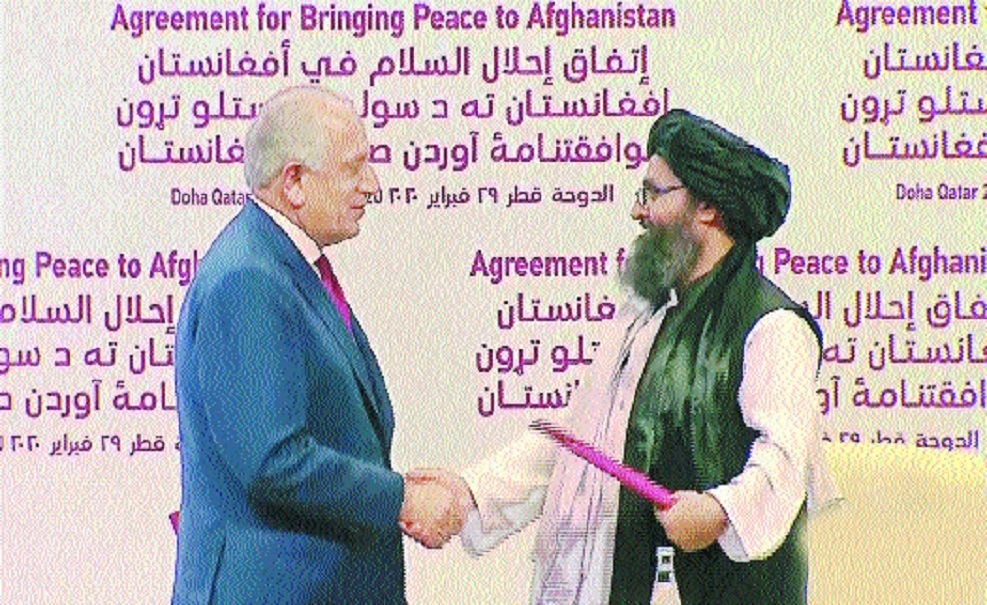Dealing with the ‘deal’
| Date :02-Mar-2020 |

By Rahul Dixit :
Indian forces on ground can resist the Taliban but enhancing the strength of the Afghan defence and security forces can be of bigger benefit. The Doha deal has made it imperative for India to extend military support to Afghanistan.
A STRANGE mix of hope and apprehension has enveloped Afghanistan after the signing of the landmark deal between the United States and Taliban to begin a process to achieve lasting peace in the war-torn country. The tinge of skepticism stems from the series of U-turns, misunderstandings, circumspection, and obscure circumstances that preceded the peace deal for last 17 months. It has left a large amount of doubt behind efficacy of the historic pact.

There is an extensive danger of build-up of a fake facade of satisfaction by the two signatories of the peace deal to hammer out success of the effort in the next 14 months. Both, the Taliban and the US Government, are seeking an honourable way to protect their own interests post withdrawal of American troops from Afghanistan. If that happens and the US soldiers fly out towards home then there is a dangerous scope of Afghanistan turning into a tinderbox, a prospect that would leave India in a precarious position. The deal struck in Doha in the presence of Indian ‘observer’ P Kumaran opens a process for intra-Afghan talks as the Taliban leadership and the Afghan Government under President Ashraf Ghani come face to face for the first time.
All the peace talks with Taliban initiated by US Special Representative Zalmay Khalilzad did not have the Afghan administration. In effect, the Doha deal will work as the facilitator for a dialogue where the Taliban will negotiate on the assurances it has given to the US Government and not the Afghan people. Though the United States has unequivocally warned of nullifying the deal if the Taliban insurgents renege on the security commitments, the outcome always would be a matter of perception. US President Donald Trump has a poll promise to keep of withdrawing soldiers from “somebody else’s war” before he seeks another mandate in November.
A look at the final premise for the deal gives an idea behind the arrangement. “Reduced violence” through the last week was the condition for the peace pact which casts doubt over the agreement reaching a meaningful path. Both the scenarios force India to be ready with its own strategy instead of being part of someone else’s policies.
Things at stake in Afghanistan are huge from security as well as political perspective. Pakistan military-jihadi complex holds a big influence over Kabul. The deal is set to give Pakistan an upper hand as it had brought Taliban to the negotiations table. A free run to Taliban and Pakistan through administration with the Afghan Government will be catastrophic for Indian insterests. India has made a good start with recalibration of its foreign policy towards Afghanistan. The Indian Ambassador to Qatar was an official invitee to observe the signing of the US-Taliban agreement. It opens a diplomatic door for India to be a part of the future process even if entails dialogue with the Taliban.
India was averse to talking to the militant group but has made a prudent change in its stance. It will be only the first step for New Delhi to activate its new Afghan strategy. India must consider that chances of an open and meaningful democracy in Afghanistan are bleak once Taliban joints the administration in whatever form. There is a standing antipathy between the Taliban and Afghan Government. The Taliban is an offspring of an arrangement between Pakistan, Saudi Arabia and the US to take on the Soviet Red Army that put foot in Afghanistan in 1979. After the Soviet retreat from the ‘Graveyard of Empires’, the US, too, lost interest and Pakistan’s ISI gained control over the militant group. Things took a drastic turn after the 9/11 attacks and the US entered Afghanistan to get locked into an unwinnable war. Trump is impatient to get out of the war theatre through the tool of a peace arrangement with Taliban. A militant group’s assurance on maintaining peace is as strong as thin ice.
So, India must revise its approach given a significant context shift. India has options to be an active player on the ground to contain both Pakistan and Taliban. In a recent report in the Observer Research Foundation there was a mention of Afghan National Security Advisor Hamdullah Mohib asking for Indian boots in his country. It was later termed as fake news on Twitter. Revisit to the old demand of positioning of Indian troops is a possibility given the shift in stance.
The reason behind the decade-old demand was Indian military involvement in Afghanistan will open a new front away from Kashmir forcing Pakistan to divert it resources. Whether India is warming up to the bold idea will be known in the next few months. Security on the ground in Afghanistan is essential for India to further its economic interests through the strategic Chabahar port in Iran. There is no change of India’s interests in Afghanistan. New Delhi is like a big brother taking care of building democratic process and infrastructure for a good future of the country. In wake of US Army’s withdrawal the situation is likely to worsen under Pakistan and Taliban control if a weak Government is elected in Afghanistan.
Given the changed political situation, building up Afghanistan administration’s capacity is another option that India has to consider in the right earnest. If not troops on the ground, India can play a vital role by building strength of the Afghan defence and security forces including Army, police and air force. A strong security mechanism under control of the administration will be a potent weapon to keep the insurgents in check. According to various studies, the Afghan security and defence forces are facing numerous challenges and need immediate reforms. Most are related to lack of quality human resources despite having bulk of financial resources pumped in by the US. The studies have established that Afghan defence forces lack strong and effective leadership, and standardised training. Taking over the leadership role to train Afghan forces is the easiest option for India to step on the soil and build a strong force as required by its interests. India can also train the Afghan police to counter insurgency given its excellent record in Jammu and Kashmir as well as Northeast. Help in technology is another step that should be taken through the Army Service Corps and Engineering and Medical units.
Providing training to Afghan personnel in repair and maintenance of its facilities will take care of the low morale and health of the forces, a key area marked by the studies. Indian forces on ground can resist the Taliban but enhancing the strength of the Afghan defence and security forces can be of bigger benefit. The Doha deal has made it imperative for India to extend military support to Afghanistan.